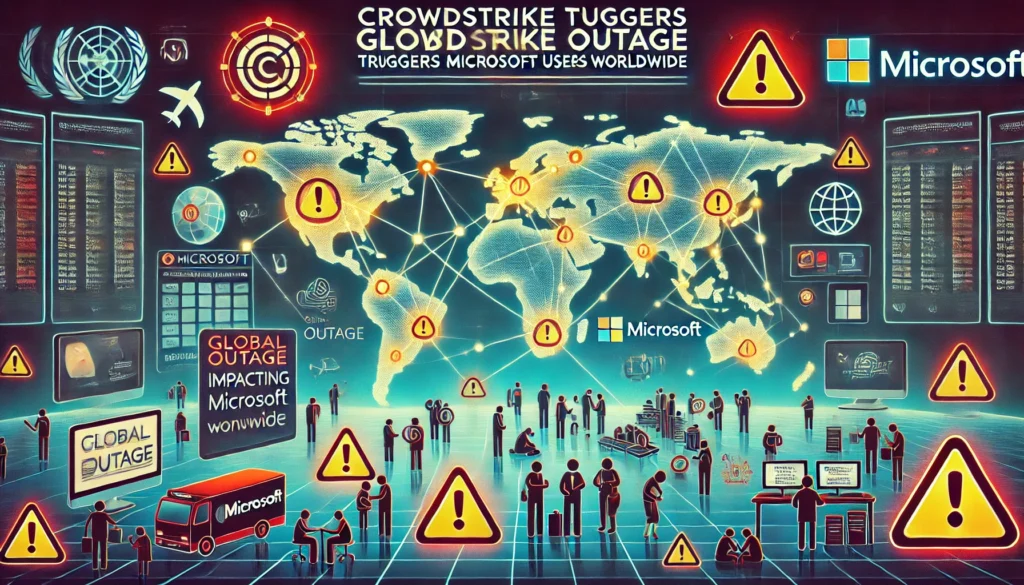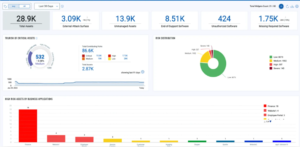The Digital Domino Effect: How a CrowdStrike Glitch Triggered Global Chaos in Microsoft Services

The Global Outrage: How a Simple Software Update Sparked Worldwide Disruptions
Imagine a world where a simple software update ignites a global catastrophe, unravelling the intricate web of our digital existence. It reads like a chapter from a Dan Brown thriller, where the smallest glitch spirals into chaos. Banks freeze, planes are grounded, hospitals plunge into disarray, and media outlets fall silent.
In a stunning twist of fate, CrowdStrike’s update triggers a domino effect, exposing the fragile threads holding our interconnected world together. As the digital fabric tears apart, the race against time begins, mirroring the high-stakes urgency and suspense found in Brown’s most gripping novels.
On July 19, 2024, a seemingly routine software update from CrowdStrike, a leading cybersecurity firm, triggered a cascade of global outages that disrupted Microsoft users across various sectors. This incident highlighted the vulnerabilities inherent in our interconnected digital infrastructure and underscored the critical need for rigorous testing and contingency planning in software updates.
The Incident Unfolds
The outage began with a faulty software update from CrowdStrike, which inadvertently.
affected Microsoft 365 applications. The repercussions were immediate and widespread, impacting banks, airlines, healthcare providers, and media outlets around the globe. Thousands of flights were grounded, hospitals faced operational disruptions, and essential services like pharmacies and broadcasters were severely affected.
This technological failure illustrated the extensive reach and profound impact of a single misconfiguration.
Catalyst of the Outage
CrowdStrike’s CEO, George Kurtz, quickly addressed the situation, explaining that the outage was due to “a defect in a single content update for Windows hosts.” He emphasized that this was not a cyberattack but rather a misconfiguration affecting numerous Microsoft customers.
The rapid identification of the issue was crucial, but the incident still revealed the fragility of even the most trusted cybersecurity measures.
What is BSOD
Immediate Consequences
The fallout from the outage was severe and far-reaching. Major airlines, including American Airlines and Delta, halted flights, while hospitals in Germany cancelled elective surgeries due to system access issues.
In the UK, pharmacies struggled to access prescriptions, and some broadcasters went off-air entirely. The Swiss Federal Office for Cyber Security confirmed that CrowdStrike’s software update was the source of the problem, underscoring the widespread impact of this technological glitch.
Financial Market Reactions
The stock market reacted sharply to the news. CrowdStrike’s shares plummeted by as much as 14.5% before recovering slightly to an 8.5% decline.
Conversely, competitors like SentinelOne and Palo Alto Networks saw their stocks rise, reflecting investor sentiment regarding the reliability of cybersecurity firms in light of the incident. Microsoft shares experienced a minor decline of 0.2% amidst the chaos.
Corporate Communications
Both CrowdStrike and Microsoft responded to the crisis with transparent communications. Microsoft’s chief communications officer, Frank Shaw, acknowledged the issue and assured customers that support was being provided. This proactive approach was essential for maintaining trust during such disruptive events. Additionally, CrowdStrike’s George Kurtz communicated via social media, apologizing for the inconvenience and clarifying that the incident was not a cyberattack.
Lessons and Future Considerations
This incident serves as a critical reminder of the importance of thorough testing and robust contingency planning in software updates. Cybersecurity experts, including Ajay Unni, CEO of StickmanCyber, have emphasized the need for firms to ensure their systems can withstand failures and continue operating under adverse conditions.
The necessity for comprehensive risk management strategies has never been more apparent, as organizations must prepare for potential disruptions to maintain operational continuity and customer trust.
Impact on CrowdStrike’s Reputation
As a leading cybersecurity provider valued at approximately $83 billion, CrowdStrike now faces scrutiny regarding its reliability and the robustness of its solutions. This incident highlights the challenges even prominent firms encounter in ensuring the resilience of their services, raising questions about their ability to prevent similar occurrences in the future.
Conclusion
As services gradually resume following the outage, the incident underscores the complexities and responsibilities associated with our reliance on digital infrastructure. While CrowdStrike’s prompt response is commendable, the fallout from this event emphasizes the critical need for thorough testing and contingency planning in software updates to prevent such widespread disruptions in the future.
Microsoft’s Communication Strategy During the Outage
During the global outage, Microsoft communicated with its users through several channels to provide updates and guidance:
- Social Media Updates: Microsoft utilized its official social media accounts, particularly X (formerly Twitter), to inform users about the outage. They acknowledged the issue impacting Microsoft 365 apps and services, reassured users that they were investigating the situation, and stated that they were working to reroute affected traffic to restore functionality.
- Microsoft 365 Status Page: The company maintained an updated status page that provided real-time information about the outage. This page included details about the services affected and the progress being made to resolve the issues. Users were advised on steps they could take, such as restoring their Windows 365 Cloud PC to a previous state if necessary.
- Direct Communication with Customers: Frank Shaw, Microsoft’s chief communications officer, communicated directly with customers, acknowledging the disruptions and assuring them that support was being provided. This level of transparency was crucial in maintaining trust during the crisis.
- Collaboration with CrowdStrike: Microsoft worked closely with CrowdStrike to address the issue. George Kurtz, CrowdStrike’s CEO, also communicated via social media, clarifying that the incident was not a cyberattack but rather a defect in their software update. He expressed apologies for the inconvenience and confirmed that a fix was being deployed.
Summary of Microsoft’s Response
Overall, Microsoft’s communication during the outage was characterized by promptness and transparency. By leveraging social media, maintaining an updated status page, and providing direct communication to customers, Microsoft aimed to keep users informed and mitigate the impact of the outage on their operations.
Conclusion
The incident serves as a stark reminder of the interconnectedness of our digital infrastructure and the potential for widespread disruptions from seemingly minor software issues. It underscores the importance of thorough testing, robust contingency planning, and transparent communication in managing such crises.







